Details of JA Architecture's 4th-prize Bauhaus Museum Dessau entry, "Six Rooms"
By Bustler Editors|
Thursday, Sep 17, 2015
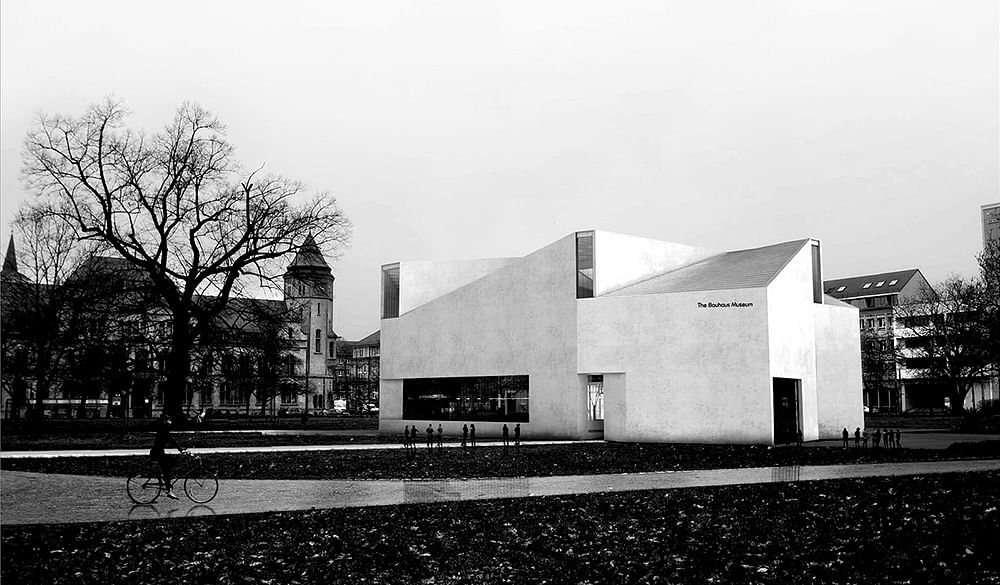
Related
The recently concluded Bauhaus Museum Dessau competition attracted a mix of proposals for the Bauhaus' proposed museum for the city of Dessau in Germany. The Bauhaus Dessau Foundation launched the open international competition last year in hopes to construct the museum, in time to mark the centennial anniversary of the Bauhaus in 2019.
At the end of the two-stage competition, Nima Javidi and Behnaz Assadi of Toronto-based JA Architecture Studio scored fourth prize with their proposal, "Six Rooms".
Check it out in full detail below.
Project description:
"Concept: Six rooms merge on the edge of a park, each room housing one of the programs that once formed the Bauhaus, each calling for autonomy yet playing a part in a co - hesive whole. The delicate balance between autonomy and participation becomes a narrative for one of the most interdisciplinary institution of the past century, The Bauhaus; where art, design, craft, culture and politics formed a force field of modernism. The gathering of the rooms will also become a programmatic framework for the function of The Bauhaus Museum Dessau and its curatorial concept.
The Urban role: The arrangements of the rooms on the ground perform multiple urban requirements and conditions that the Museum building has to address. From forming an urban edge for the Kavalierstraße to acting as a gateway to the park for an everyday passage from Antoinettenstraße to Ratsgasse and to create local fragments of outdoor gathering and exhibitions around its perimeter, the project addresses the every day life aspect of the museum on the ground and the exhibition of the respective activities on the permanent exhibition level above.
Visitor Experience: Visitors can access the building both from the grand entry on Kavalierstraße or the walkway from the park. The ground floor of the building is dedicated to vibrant activities and the upper levels to the permanent exhibitions, the topos of each room on the exhibition level will correspond to the everyday function underneath, the Clubhouse topoi will be above the café, the School topoi above the education center, The Factory above the workshop,..."
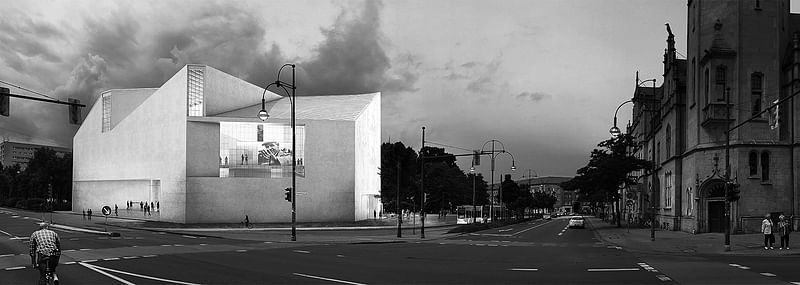
"Open space and parking area: By carefully placing an urban artifact with a compact footprint on the edge of an already active park the project tries to engage with an existing ecological, historical and pedestrian framework of the park. With minimal alteration, the outdoor exhibition areas of the museum are treated with gradually paved surfaces providing a surface for moments of use in an existing landscape rather than clearly defined institutional boundaries. The clients proposed parking area has been paved and used to accommodate the required parking spaces.
Space and program: Three main spaces (entry hall, temporary and permanent exhibition halls) will form the core of the visitor experience. Two peripheral zones (logistics and café on the north and administration and education center on the south) will accommodate the service, support and administrative spaces of the museum around the main core."
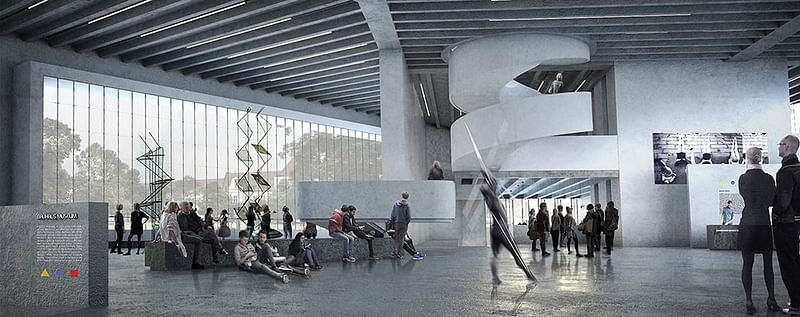
"Entry hall: The deep recessed entry on Kavalierstraße and the narrow and tall entry on the park will bring the visitors to the entry hall. An open and accessible central space with 8m high ceiling that all perimeter rooms open up to; café, exhibition, education center, ticketing booth, shops, all turning the space into a vibrant cultural hub for the passage of visitors, students, staff and art.
II. Temporary exhibition space: The temporary exhibition space is divided to two parts that are connected by a barrier free accessible ramp (6% slopes). The first part is bright and directly accessible from the entry hall with a panoramic window to the park and the second part is at the mezzanine level and will accommodate the artworks of the temporary exhibition that are more sensitive to light and will be artificially lit. This mezzanine will also act as an intermediate sequence in the visitors’ trajectory from the entry hall to the permanent exhibition hall above."
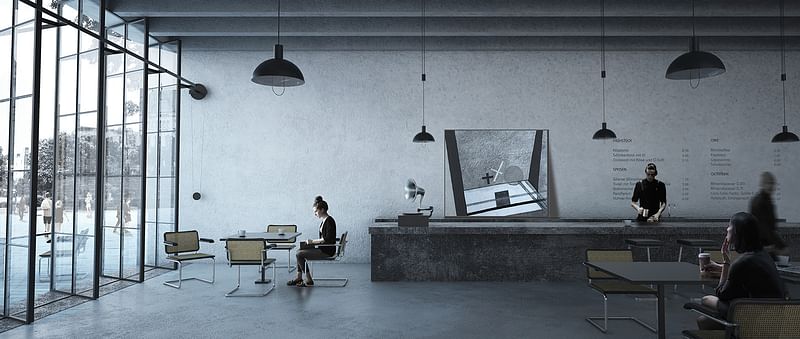
"III. The permanent exhibition hall How to design a space that is both flexible enough to accommodate an unpredictable range of curatorial strategies and is articulated enough to be able to address the notion of six different topoi of the museum? The rather autonomous rooms on the ground floor merge to form one grand, co - hesive permanent exhibition hall on the second floor. A generous 1800 SM unobstructed space allowing the curators to have maximum freedom in organizing the permanent collection of the Bauhaus, the roof will be a structural folded plate that hovers above the floor and set the light and ambience under itself. The geometry of the folded roof plates with their different joist orientations and light capturing conditions will create a nuanced ambience for each topos on the exhibition hall. The clearstory(?) openings to the exhibition hall are not to provide natural light but to set the ambience and can be blocked or dimmed using mechanically operated curtains. The visitor’s sequential experience of the museum will conclude when they arrive via a spiral stair (or the elevator) from the mezzanine level to the center of the exhibition hall. The unmediated and direct encounter with the curated legacy of Bauhaus in one generous and unobstructed space will be the first impression that the viewers get from the exhibition hall and perhaps the one to last.
IV. Logistics and the café The logistics and administration office are separated and each grouped with more vibrant functions such as café and education center to avoid creating a back of the house feel on any side of the building thus assuring vibrancy of use and easy integration to the park independent from the hours of operation of the museum. The art delivery, distribution and storage are organized on the north quadrant of the building accessed by an oblique driveway for the trucks from Friedrichstraße. The logistics of the building will be both at grade and in the basement and is connected to all of the exhibition floors by an art handling elevator. Café is also located at the north quadrant to soften the service character of that side by its windows and its patio outside. The café patio and the vehicular access to the building will form a public paved area on the north east side of the park with subtle measures to define zones of different use ie a small raise on the pavers or stainless steel bollards. The extension of the café patio towards the park forms the outdoor exhibition area of the museum on the north.
V. Education and administration The education center and the event space are grouped together along the group ticket booth and the administration mezzanine on the south quadrant of the building. An outdoor exhibition area in front of the workshop will be used by the students for the outdoor activities as well as an exhibition area for the museum to assure a degree of vibrancy on the south side where the building footprints bends in to embrace the memorial for the victim of Fascism. A separate set of washrooms will service the south quadrant to create autonomy from the hours of the operations of the museum for the administration and Education quadrant."
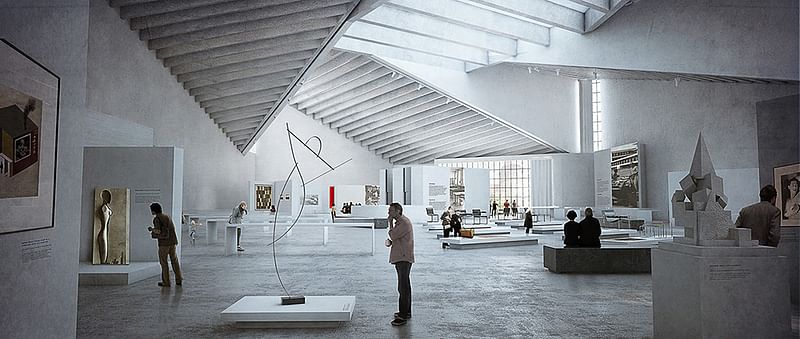
"Building Systems
The technical systems proposed in this section are meant to be suggestive based on the designers preliminary discussions with technical consultants and are less to prove the buildability of the proposal than are to propose a framework to think about building technology as a set of decisions that can extend the conceptual ideas behind the design all the way to the building details, technical systems and construction methods. An idea and a premise deeply rooted in Gropius’s ideology and Bauhaus’s formation and development.
I. The structure The structure of the building will be a series of post-tensioned one way ribbed reinforced concrete floors supported by the perimeter load bearing walls and the diagonal shear walls in the center. The shear walls are organized like a pinwheel that will resist the lateral and seismic loads. The shear walls are proposed to stop at the exhibition hall and the load of the roof spanning over the exhibition hall will be transferred to the perimeter by five diagonal deep beams that taper towards the center and are tied together with a 2m central concrete rim. The deep central rim will incorporate multiple light-diffusing layers to carry a dim natural light to the center of the exhibition."
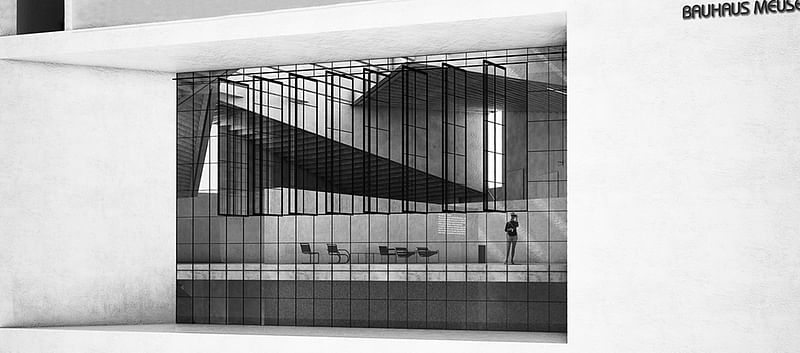
"II. Mechanical systems
Heating- radiant floor heating embedded on the concrete floor topping combined with strategic locations for Radiators will provide the heating required for the building Ventilation will be done by heat recovery ventilator units attached to the soffit of the deep inset windows on each floor and distributed across the hall by exposed ductworks.
Cooling- Using the thermal mass of the exterior and interior massive concrete shear walls and the low opening ratio (less than 25%) the cooling load will be minimized architecturally. A mechanical room in the basement will accommodate the air handling units and the access to open air will be provided via underground trenches to the at grade grills on the green patch on the north side of the project where the compressors will be located (to be detached from the park the service access path and the building). The distribution of cool air will be done by exposed ductwork between the concrete joists on the ceiling of the first floor feeding both the first floor and the exhibition hall.
III. Building Envelope Thermal mass and Breathable lime plastered Wall system Building envelope is proposed to be 700 mm insulated concrete walls with all of the concrete to be cast on the warm side of the insulation and rendered with lime plaster both on the interior and the exterior. The window areas are reduced and the increased mass of the envelope functions as thermal mass to store energy over a long time cycle and gradually dissipate it back to the occupants to create a degree of thermal comfort normally found in the historic buildings. The building will shift away from contemporary practices of multi layered facades with sophisticated mechanical equipment and move towards the new/old paradigm of using massive solid breathable walls that are built to last and create a pleasant thermal atmosphere without the extra maintenance cost associated with contemporary hi-tech low energy buildings.
Windows Steel thermally broken welded frame windows with double glazed insulated units are proposed for their high thermal performance (Uw value 1.3 W/m²K for fixed glazing) and extremely narrow face width resulting from the structural strength and torsion resistance of the steel profiles that will allow large windows with extremely slender frames as well as a reference to the tectonic of the original Bauhaus windows."
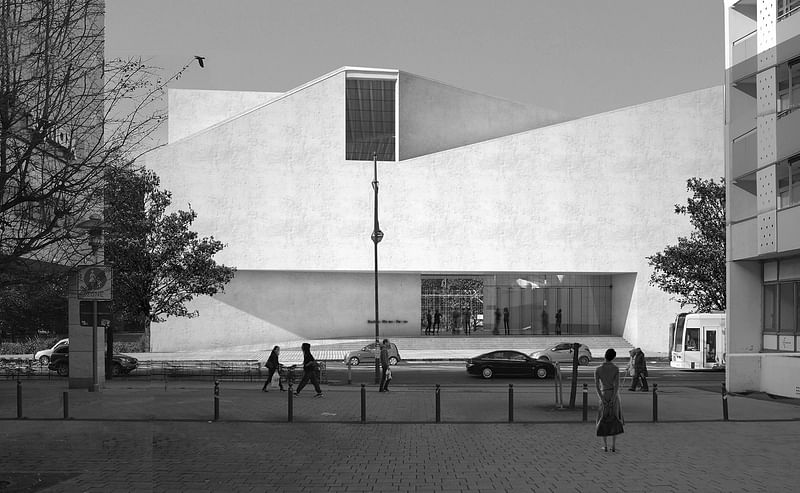
"Bauhaus and the memory: The proposal uses the quality of the Bauhaus spaces and the honest tectonic expression of the original building as a thread to connect the new museum to its reference. It proposes white massive plastered walls to capture the essence of light and geometry and it uses crafted detailing to become the tectonic expression of the building components; curtain walls, HVAC systems, railings and the interior fit-out.
These two themes; the texture of space and the crafted tectonic, will become threads that not only connect the museum to the original building but also brings back some of the existing qualities of the building that were slightly overshadowed by the very ideals that the modernist movement is known for; mass production and abstraction. The Bauhaus walls were never just white, they expressed texture and the curtain walls were not just transparent they expressed the beautifully crafted quality of its assembly. The building had a soul beyond the ideals it promoted and this proposal is an effort to capture that essence."
All images courtesy of JA Architecture Studio.
More project images in the thumbnail gallery below.
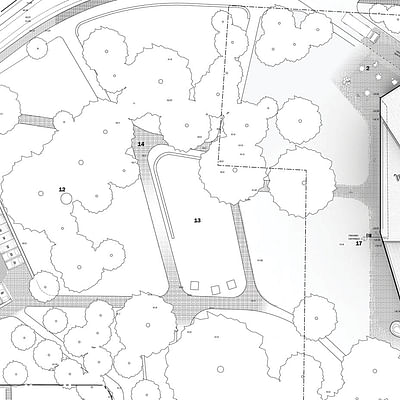

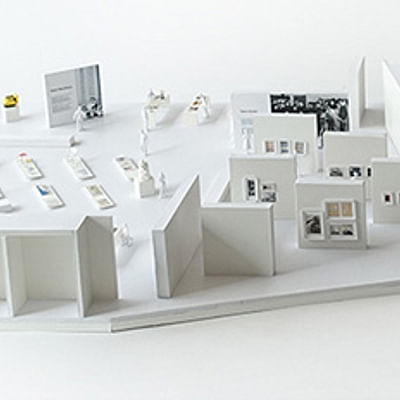
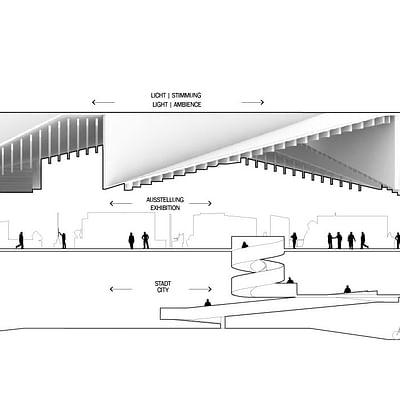
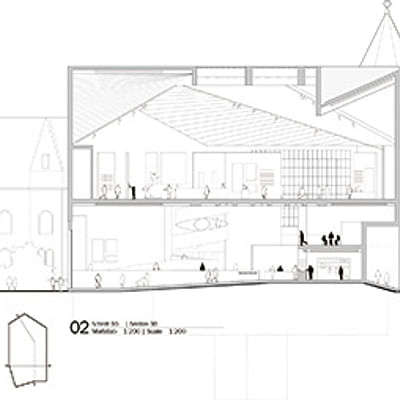
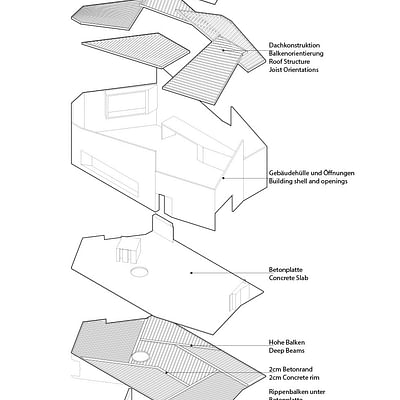
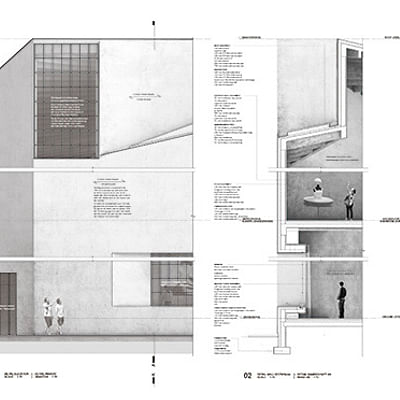
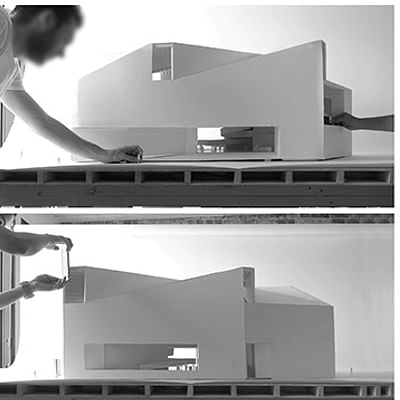
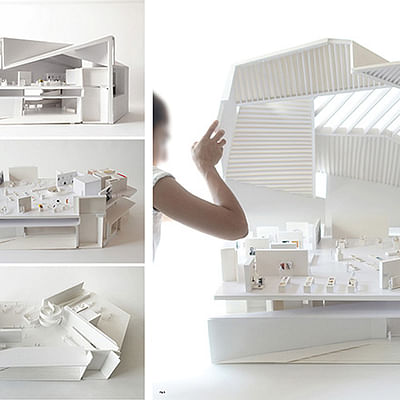

Share
0 Comments
Comment as :